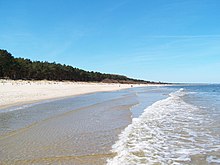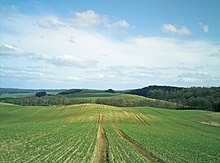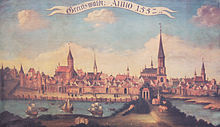District of Vorpommern-Greifswald
| coat of arms | Germany map |
|---|---|

|

Coordinates: 53 ° 46 ' N , 13 ° 53' E |
| Basic data | |
| Existing period: | 2011– |
| State : | Mecklenburg-Western Pomerania |
| Administrative headquarters : | Greifswald |
| Area : | 3,929.73 km 2 |
| Residents: | 235,623 (Dec. 31, 2019) |
| Population density : | 60 inhabitants per km 2 |
| License plate : | VG, ANK, GW, PW, SBG, UEM, WLG, (HGW) |
| Circle key : | 13 0 75 |
| NUTS : | DE80N |
| Circle structure: | 138 parishes |
| Address of the district administration: |
Feldstrasse 85a 17489 Greifswald |
| Website : | |
| District Administrator : | Michael Sack ( CDU ) |
| Location of the district of Vorpommern-Greifswald in Mecklenburg-Vorpommern | |
The district of Vorpommern-Greifswald is a district in the state of Mecklenburg-Western Pomerania . It is located almost exclusively in the central and southern part of Western Pomerania , but also includes a small Mecklenburg area on Lake Galenbeck and the Uckermark town of Strasburg to the south of it .
The district town is the university and Hanseatic city of Greifswald . In the cuirassier town of Pasewalk and in Anklam there are branch offices of the district administration. In addition to these two cities, Wolgast and Ueckermünde are also medium-sized centers . The district is a member of the transnational federation of the Euroregion Pomerania .
geography
location
The district of Vorpommern-Greifswald borders in the north-west on the district of Vorpommern-Rügen and from west to southwest on the district of Mecklenburg Lake District . In the east it borders on Poland and in the south on Brandenburg . In addition to the district town of Greifswald, the largest towns are the middle-class centers Pasewalk , Anklam , Wolgast , Ueckermünde and Torgelow . Vorpommern-Greifswald is the third largest district in Germany in terms of area .
Landscaping
The district is characterized by its coastal location between Greifswalder Bodden and Stettiner Haff .
In the north of the district there are many coastal areas with the Bodden waters (Greifswalder Bodden, Peenestrom, Krumminer Wiek, Achterwasser, Stettiner Haff), which are primarily characterized by reed belts. On the Baltic coast of the island of Usedom , the coastal strip is shaped as a long sandy beach. The water areas of the many small Bodden and Wieke run through large areas of the landscape in the hinterland to the Baltic Sea. The mainland between Anklam and Greifswald is very much characterized by agriculture. Wide fields and only smaller elevations criss-cross the landscape, which is determined by moraines and moors (Peenetalmoor, Ziesebruch, Thurbruch). The island of Usedom is the second largest island in Germany after Rügen. The island is also designated as a nature park.
The south of the district is mainly characterized by a high level of forest, which is also due to the poor soil properties. The alleys so typical of the landscape stretch along the lagoon coast and in many other parts of the region. As a result of the decades of use of large parts of the Ueckermünder Heide as a military training area for the NVA and later also for the Bundeswehr, valuable dwarf shrub heaths and grasslands have developed in these areas . In the peripheral areas, nature reserves and retreat areas are z. B. originated for sea eagles.
The Friedland Great Meadow lies between the Ueckermünder Heide and the Brohmer Mountains . It was once the largest limestone moor in northern Germany. As a result of extensive amelioration in the 1960s, however, little is left of the former flora and fauna. The meadow areas are of particular importance today as resting and feeding grounds for almost 100 breeding and 80 guest bird species.
The Brohmer Mountains are characterized by extensive red beech and mixed forests. Many forest caves and bogs are embedded in the valleys and depressions of the hilly terminal moraine. They provide the habitat for black storks, lesser spotted eagles, cranes and also red deer.
On the edge of the Brohmer Mountains is the Galenbeck lake with retreats for animal and plant species endangered in Central Europe. In the southernmost part of the district, on the border with the Uckermark, a large number of lakes, sills and moors are embedded in the soft, loamy ground moraine plates. Due to the good soils, agriculture is primarily practiced in these areas and the proportion of forest is very low here. Along the Randow Valley you can find steppe flora that is unique in Germany and is mainly characterized by dry continental grass. The natural area has been protected by the Am Stettiner Haff Nature Park since 2005 .
The most important rivers are the Peene , the Uecker, the Randow and the Ryck , of which only the Peene is completely navigable, the Uecker and Ryck only in their mouths. Ground moraines with various deposits from later stages of the Ice Age as well as moors ( Peenetalmoor , Friedländer Große Wiese, Ziesebruch , Thurbruch ) and Randowbruch characterize the surface of the circle.
Protected areas
There are 48 designated nature reserves in the district (as of February 2017).
Metropolitan area of Szczecin
The district has been actively developed since 2012 through cooperation within the metropolitan area of the metropolis of Szczecin as part of a European metropolitan region, the joint development concept was presented in June 2015.
cities and communes
The largest city in the district is the district town of Greifswald , which together with the nearby Stralsund functions as the regional center . The next largest cities are Anklam , Wolgast , Pasewalk and Ueckermünde , which in turn are medium-sized centers .
In the Regional Spatial Development Program Vorpommern (RREP) of 2010, the following basic centers in the district are also defined: Ducherow , Eggesin , Ferdinandshof , Gützkow , Heringsdorf , Löcknitz , Lubmin , Strasburg (Uckermark) , Torgelow and Zinnowitz . The integrated region with Poland also benefits from the city offers of Szczecin , which forms a cross-border conurbation .
Cities and municipalities including the number of inhabitants on December 31, 2019:
- Anklam , Hanseatic City (12,331)
- Greifswald , Hanseatic City and Large District City (59,232)
- Heringsdorf (8496)
- Pasewalk , City * (10,047)
- Strasburg (Uckermark) , City (4635)
- Ueckermünde , town (8442)
Offices with municipalities and cities
belonging to the office * Seat of the official administration
Sankt Marien in Anklam
Lubmin with the beach
Territory changes
- Dissolution of the municipalities of Buddenhagen and Hohendorf - incorporation into the city of Wolgast (January 1, 2012)
- Dissolution of the Neuendorf A community - incorporation into the Ducherow community (January 1, 2012)
- Dissolution of the Neuendorf B community - incorporation into the Spantekow community (January 1, 2012)
- Dissolution of the municipality of Putzar - incorporation into the municipality of Boldekow (January 1, 2012)
- Dissolution of the communities of Damerow and Züsedom - incorporation into the community of Rollwitz (January 1, 2012)
- Dissolution of the communities of Blumenhagen and Klein Luckow - incorporation into the community of Jatznick (January 1, 2012)
- Dissolution of the community of Düvier - incorporation into the city of Loitz (July 1, 2012)
- Merger of the municipalities of Liepen and Neetzow - new formation of the municipality of Neetzow-Liepen (January 1, 2014)
- Dissolution of the communities Heinrichsruh and Torgelow-Holländerei - incorporation into the city of Torgelow (May 25, 2014)
- Dissolution of the Kölzin community - incorporation into the city of Gützkow (May 25, 2014)
- Dissolution of the municipality of Diedrichshagen - incorporation into the municipality of Weitenhagen (May 26, 2019)
- Merger of the municipalities of Karlsburg and Lühmannsdorf - new formation of the municipality of Karlsburg (May 26, 2019)
history
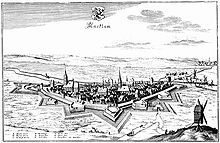
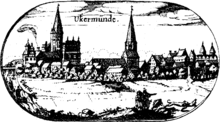
Today's district of Vorpommern-Greifswald comprises the southern part of Western Pomerania , the part of the former Prussian province of Pomerania that remained with Germany after the Second World War, as well as small parts of the Uckermark and Mecklenburg .
prehistory
The first people came to the region after the Vistula Ice Age . In the valley of the Randow near Wollschow , in the Schwingetal southwest of Greifswald and in many other places in the district, a number of large stone graves and stone boxes testify that members of the Neolithic funnel cup culture , around 4000 BC. BC, populated the space. For example, the so-called "whale grave" (Wollschow 34) is a stone box that was excavated in 1929. It owes its name to the shape of the capstone. In the chamber measuring only 0.8 × 0.5 m, three child skeletons were found in a crouched position (legs drawn up) and a ceramic bowl .
Shell stones , barrows and many uncovered settlements in the region, which were found especially during the construction of the A 20 and the gas pipelines from Lubmin, are monuments from the Bronze Age (Germanic peoples).
Early Middle Ages
With the migration of peoples around 400 to 600, the Germanic tribes moved from the area towards the south and west.
From the 6th to the 7th centuries, Western Slavs moved to the partly deserted region. The individual tribes, such as the Ukrer / Ukranen , Redarians and Zirzipans belonged to the turns that can be assigned to the League of Liutizen . Many castle walls, settlements and grave fields bear witness to the Wende to this day.
With the destruction of Rethra and the Jaromarsburg on Arkona in 1168, the downfall of the Slavs was driven forward. The Slavs were Christianized and monks settled in the region.
12th to 19th centuries
In the 12th century, German settlers from Holstein, Lower Saxony and Westphalia came to the region and brought modern farming methods with them. In the period that followed, handicrafts and fishing developed alongside the main source of income from agriculture. The goods obtained were also sold through the Hanseatic League. The most important trade routes of the time were the sea routes across the Baltic Sea as well as river and road connections to the hinterland. In the south, coal piles and brickworks developed to use local clay deposits. In addition, lawn iron ore from the region and pig iron from Sweden were processed in the ironworks.
During the Thirty Years War, the area was almost completely depopulated. Only with the Peace of Westphalia, with which the area fell to Sweden, was the area slowly repopulated. In 1720, with the Treaty of Stockholm , the area south of the Peene , including the island of Usedom, fell to Brandenburg-Prussia . During this time, agriculture continued to be cultivated. Craft businesses such as sawmills, charcoal burners, ironworks and shipyards emerged here, and regular forestry was introduced.
After the Seven Years' War (1756–1763), agriculture was further cultivated, dairies were established and livestock were increased, and crop rotation was introduced. The population doubled in less than 100 years. Due to the brisk factory activity of brickworks, iron foundries and cutting mills, more and more people found their main occupation in industry. Agriculture was only a sideline.
After 1945
After 1945 collectivization was promoted in connection with the industrialization of agriculture. Fishing was also industrialized and fish processing plants were created. The southern region was shaped by the stationing of NVA troops and the establishment of military training areas . The northern part of the country was predominantly agricultural. Large companies for food production were established here.
In 1945, at the instigation of the Soviet occupying power, the state of Mecklenburg-Western Pomerania was founded, which was renamed "Mecklenburg" in 1947. The middle level of state administration in the GDR was reorganized in 1952. In place of countries were GDR districts . The area of the "State of Mecklenburg" was divided into the districts of Rostock , Schwerin and Neubrandenburg . The southernmost tip of Western Pomerania from today's state border of Mecklenburg-Western Pomerania from Grünz in the west to the state border between the GDR and the Republic of Poland in the east was assigned to the Frankfurt (Oder) district ; after 1990 it remained as the Gartz (Oder) office in the state of Brandenburg .
In the respective districts of Rostock and Neubrandenburg, the GDR districts of Greifswald , Anklam , Wolgast , Strasburg (partially), Pasewalk and Ueckermünde and, from 1974, the urban district of Greifswald were formed at the same time in the area of today's district of Vorpommern-Greifswald .
Post-turnaround time
After reunification, the region was reorganized, not least in terms of agriculture.
Today the region is characterized by a very low density of settlements and a diverse natural area.
District reforms
During the district reform in 1994, the GDR districts became the Ostvorpommern district , the Uecker-Randow district and the independent Hanseatic city of Greifswald . Two offices in today's Vorpommern-Greifswald district were also in the Demmin district from 1994 to 2011 .
The district of Vorpommern-Greifswald ( planning name: district of Südvorpommern ) was formed in the course of the Mecklenburg-Western Pomerania district reform on September 4, 2011 from the city of Greifswald , the districts of Ostvorpommern , Uecker-Randow and parts of the Demmin district (offices of Jarmen-Tutow , Peenetal / Loitz ).
The centrally located Anklam was also initially considered as a district town . In the end, however, the state parliament decided in favor of the most populous city of Greifswald .
In the state, district and district elections on September 4, 2011, in a referendum on the name of the district, the majority fell on "Vorpommern-Greifswald" and thus not on the alternative "Ostsee-Haffkreis Vorpommern".
politics
District council
The district council of the Vorpommern-Greifswald district consists of 69 members. Since the election on May 26, 2019, it has been composed as follows:
- Election results of past elections
| Parties and constituencies | Percent 2019 |
Seats 2019 |
Percent 2014 |
Seats 2014 |
Percent 2011 |
Seats 2011 |
Percent 2009 |
||
|---|---|---|---|---|---|---|---|---|---|
| CDU | Christian Democratic Union of Germany | 29.2 | 20th | 34.6 | 24 | 28.3 | 19th | 33.9 | |
| AfD | Alternative for Germany | 16.9 | 12 | 4.9 | 3 | - | - | - | |
| THE LEFT. | THE LEFT. | 12.9 | 9 | 17.7 | 12 | 18.7 | 13 | 23.0 | |
| SPD | Social Democratic Party of Germany | 10.5 | 7th | 13.3 | 9 | 19.7 | 14th | 12.7 | |
| GREEN | Alliance 90 / The Greens | 8.3 | 6th | 4.0 | 3 | 6.1 | 4th | 4.1 | |
| KfV | Competence for Western Pomerania | 6.4 | 4th | 9.8 | 7th | 9.5 | 7th | - | |
| FDP | Free Democratic Party | 3.3 | 2 | 2.3 | 2 | 3.1 | 2 | 6.8 | |
| Animal welfare party | Human Environment Animal Welfare Party | 3.1 | 2 | - | - | - | - | - | |
| NPD | National Democratic Party of Germany | 2.8 | 2 | 6.6 | 5 | 9.0 | 6th | 6.3 | |
| FREE VOTERS | FREE VOTERS | 2.4 | 2 | - | - | 1.0 | 1 | 1.4 | |
| BG | Greifswald citizens' list | 1.8 | 1 | 1.9 | 1 | 1.1 | 1 | 1.9 | |
| Free horizon VG | Free Horizons - Alliance for Western Pomerania | 0.7 | 1 | - | - | - | - | - | |
| WG BV-LR | Voting community farmers' association-rural area | - | - | 1.4 | 1 | 1.4 | 1 | 1.0 | |
| PIRATES | Pirate Party Germany | - | - | 1.3 | 1 | 1.5 | 1 | - | |
| Others | 0.5 | - | 1.6 | 1 | 0.6 | - | 9.9 | ||
| Individual applicants | 1.3 | 1 | 0.4 | - | - | - | 0.3 | ||
| total | 100 | 69 | 100 | 69 | 100 | 69 | 100 | ||
| voter turnout | 56.5% | 47.7% | 50.3% | 47.1% | |||||
- Others: 2019: Landleben Tollensetal (0.3%), WGK (0.2%), 2014: AL (0.9%), UBL 94 (0.3%), BBG (0.3%) and WG B (0.1%); 2011: FWG Jarmen (0.3%) and UWG (0.3%); 2009: IfA (3.0%), BB UER (2.8%), WIP (0.8%), UWG (0.4%), WIK (0.4%), BfP (0.4%) , WGK (0.3%), WGLR (0.3%) and UBL 94 (0.1%).
- Individual applicants: 2019: Lars Bergemann (1.0%), Veit Vielhaber (0.3%), Michael Koch (0.0%), 2014: Matthias Bahner (0.2%), Martin Schindler (0.2%) ; 2009: k. A.
- The result of the district election in 2009 was converted to the 2011 election area.
In the district council (as of April 2020) the following parliamentary groups (at least 4 district council members) were formed: CDU (21 members, including 1 member FREE VOTERS), AfD (12 members), DIE LINKE. (9), SPD (7), GRÜNE (6 members), FDP / FH / BG (5 members, incl. 1 member FREE VOTERS), KfV (4 members). There are 5 non-attached district council members: Tierschutzpartei (2 members), NPD (2 members), individual applicants Bergemann (1 member). Voting in the district council takes place with changing majorities.
The district (constituency number 75) consisted of 303 electoral districts with 201,181 eligible voters. 113,612 voters went to the polls, casting 326,163 valid votes. This corresponds to a voter turnout of 56.5% (all data from 2019, official final result).
In September 2018, the parliamentary groups were composed as follows: CDU (25 members), Die Linke (11), SPD (9), Kompetenz für Vorpommern (6), parliamentary group NPD (5), Bündnis 90 / Die Grünen - forum seventeenvier (4). 9 members of the district council were non-attached.
More information on the electoral process and legal provisions : District Council (Mecklenburg-Western Pomerania)
District Administrator
Election 2018
Michael Sack (CDU) was elected district administrator in June, who clearly prevailed against the AfD candidate in the runoff election.
| candidate | 1st ballot (May 27, 2018) | Runoff election (June 10, 2018) | ||
|---|---|---|---|---|
| be right | proportion of | be right | proportion of | |
| Michael Sack (CDU) | 26,675 | 41.5% | 38,844 | 79.5% |
| Axel Gerold (AfD) | 10,078 | 15.7% | 10,002 | 20.5% |
| Dirk Scheer (individual applicant) | 9,703 | 15.1% | ||
| Monique Wölk (SPD) | 8,043 | 12.5% | ||
| Ulrike Berger (Greens) | 7,344 | 11.4% | ||
| Kai-Uwe Ottenbreit (individual applicant) | 1.927 | 3.0% | ||
| Andreas Suttor (individual applicant) | 523 | 0.8% | ||
| Eligible voters | 201.815 | 201.605 | ||
| Voters | 65.206 | 32.3% | 49,512 | 24.6% |
| of which valid votes | 64.293 | 98.6% | 48,846 | 98.7% |
Election 2011
To Landrätin was in September 2011 with 59.5% Syrbe Barbara by the party Die Linke selected who had previously acts since 2001 as district administrator of the district Ostvorpommern and in a run-off against the CDU candidate and current State Justice Minister Kuder Uta-Maria prevailed .
coat of arms
|
Blazon : “Divided by silver and gold by a slanted blue bar; covered by an upright, gold-armored red griffin with a raised tail. "
The coat of arms was designed by Ralf-Gunnar Werlich from Greifswald . It was approved on March 18, 2014 by the Ministry of the Interior and registered under the number 350 of the coat of arms of the state of Mecklenburg-Western Pomerania. |
|
| Justification of the coat of arms: On December 9, 2013, the district decided to accept a coat of arms after an ideas competition. |
The municipal coats of arms of the district are listed in the list of coats of arms in the Vorpommern-Greifswald district .
Economy and Transport
economy
The district shows a strong north-south divide in terms of economy. While the city of Greifswald as a science and technology location and the island of Usedom as a tourist center in Mecklenburg-Western Pomerania are economically stable in the northern parts of the district , in the hinterland there are few economic alternatives besides agriculture and some tourism (which suffers from a shortage of skilled workers ). Renewable energies, especially wind power, are being expanded significantly, but are hardly supporting the local economy.
Other branches of industry in the district are wood and food processing, the construction industry and the metal processing industry. The largest employer in the district is the University of Greifswald with 5029 employees. The Bundeswehr is represented with 2,400 soldiers and 410 civilian employees in barracks and facilities in Eggesin, Torgelow, Viereck and Wolgast as well as a military training area (Jägerbrück).
Important larger companies are:
- Stadtwerke Greifswald
- Anklam sugar factory in Anklam
- Cheplapharm Arzneimittel GmbH in Greifswald
- HanseYachts AG in Greifswald
- Medigreif group of companies in Greifswald
- Riemser Arzneimittel AG in Greifswald
- Sparkasse Vorpommern in Greifswald
- Energiewerke Nord in Rubenow
- Torgelow iron foundry in Torgelow
- Peene shipyard in Wolgast
- BSW Handels GmbH (archery world) in Anklam (Europe's largest archery shop)
traffic
Street
The district of Vorpommern-Greifswald can be reached from Hamburg and Berlin via the federal motorways 20 and 11 .
The district of Vorpommern-Greifswald is accessed by several federal roads. The federal highways 109 and 105 from Berlin to Stralsund , which run through the middle of the district, are of supraregional importance . The federal highways 104 , 105 , 109 , 110 , 111 and 113 open up the district area. Furthermore, federal highways 197 and 199 begin in Anklam.
train
The railway lines run through the district:
- Berlin - Züssow - Greifswald - Stralsund ( main line Berlin-Stralsund ), ( DB Regio and DB Long- Distance IC / EC / ICE)
- Lübeck - Pasewalk - Stettin (Szczecin) ( Bützow – Szczecin railway line ), (DB Regio)
- Pasewalk - Ueckermünde City Harbor ( Jatznick – Ueckermünde railway line ), (DB Regio)
The Züssow – Wolgast railway line and the lines on the island of Usedom ( Wolgast – Swinemünde and Zinnowitz – Peenemünde ) are owned by the Usedomer Bäderbahn (UBB).
In the holiday season, Deutsche Bahn is increasingly offering long-distance trains from the metropolitan regions in the direction of Usedom / Rügen.
Airfields
The Heringsdorf airport and the Anklam and Peenemünde airfields represent the air traffic connection. However, there are currently only a few and only seasonal airlines. The Pasewalk airfield is located three kilometers west of Pasewalk (Pasewalk-Franzfelde).
Ports
The ports are far more important. The Baltic Sea ports of Greifswald-Ladebow, Vierow, Lubmin and Wolgast and the inland port Anklam are the carriers of shipping in the district.
There are various sport boat harbors for sailing and motor boats in the district:
- on the Greifswalder Bodden in Wieck and Lubmin
- on the Peenestrom in Kröslin
- on the Stettiner Haff in Mönkebude , Altwarp and Ueckermünde
Education and Research
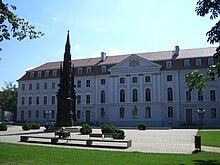

schools
Important high schools in the district include the Friedrich-Ludwig-Jahn-Gymnasium Greifswald (founded in 1561) and the Lilienthal-Gymnasium Anklam (founded in 1535). The Alexander-von-Humboldt-Gymnasium Greifswald is currently the only state-run grammar school to start classes to promote giftedness from grade 5.
The Vorpommern-Greifswald District School Council (KSR VG) was founded on March 15, 2013 to safeguard the interests of the students in the district .
university
The University of Greifswald is one of the oldest universities in Central Europe. It is characterized by good study conditions and high rankings in various subjects. The focus of teaching and research is in the areas of physics, medicine, law, economics, and cultural and historical sciences.
science
Various research institutions have settled around the University of Greifswald, such as the Friedrich Loeffler Institute , the Max Planck Institute for Plasma Physics or the Leibniz Institute for Plasma Research and Technology . Together with university medicine, they are important research locations and economic factors that have an impact far beyond the state of Mecklenburg-Western Pomerania.
religion
The Protestant parishes in the Vorpommern-Greifswald district belong to the Greifswald parish and the Pasewalk parish of the Pomeranian Evangelical Church , which was merged into the Evangelical Lutheran Church in Northern Germany in 2012 . Within this regional church near the Protestant church with the former Pomeranian is coextensive Evangelical Church of Pomerania circle with the deaneries Demmin, Pasewalk and Stralsund.
Most of the Catholic parishes belong to the Deanery of Western Pomerania of the Archdiocese of Berlin and partly to the Deanery of Neubrandenburg of the Archdiocese of Hamburg .
License Plate
On September 4, 2011, the district was assigned the distinctive signs OVP (Ostvorpommern) and UER (Uecker-Randow) of the two old districts. These retained their validity in the Vorpommern-Greifswald district until the abbreviation VG was introduced there on February 1, 2012 . The Hanseatic City of Greifswald kept its abbreviation HGW and is still there today.
In connection with the license plate liberalization , the distinctive signs ANK (Anklam), GW (Greifswald, for the then district), PW (Pasewalk), UEM (Ueckermünde) and WLG (Wolgast) have also been available since March 14, 2013 . SBG (Strasburg) was added on July 10, 2013.
The distinctive signs OVP and UER may also be used. The decision on this is made by the district, which has not yet made use of it.
Web links
Individual evidence
- ↑ Statistisches Amt MV - population status of the districts, offices and municipalities 2019 (XLS file) (official population figures in the update of the 2011 census) ( help ).
- ↑ Euroregion Pomerania - area and partners ( memento of November 17, 2015 in the Internet Archive ), accessed on November 13, 2015
- ↑ ICZM-Oder Reports 2002
- ↑ Model project of spatial planning: German-Polish development concept for the cross-border metropolitan region of Szczecin , kooperation-ohne-grenzen.de, accessed on November 25, 2016
- ↑ Development concept for the cross-border metropolitan region of Szczecin from June 8, 2015 (PDF; 2.7 MB)
- ↑ Regional Spatial Development Program Vorpommern (RREP) 2010 ( Memento from September 24, 2015 in the Internet Archive ) - central-local structure with upper, middle and basic centers, accessed on July 12, 2015
- ↑ Statistisches Amt MV - population status of the districts, offices and municipalities 2019 (XLS file) (official population figures in the update of the 2011 census) ( help ).
- ^ Result of the vote on the name of the new district
- ↑ "Cabinet decides to reform the district", Mecklenburg-Western Pomerania state portal , February 10, 2009 ( Memento from January 17, 2012 in the Internet Archive )
- ^ "Landtag approves administrative and district reform. New districts and district towns have been determined ” ( Memento from August 28, 2013 in the Internet Archive ), Mecklenburg-Western Pomerania state portal , July 7, 2010
- ^ Suggested names for naming the new districts in Mecklenburg-Western Pomerania
- ↑ a b District election 2019 in the district of Vorpommern-Greifswald
- ↑ service.mvnet.de Result of the district election 2011
- ↑ service.mvnet.de The result of the district elections 2009 converted to the 2011 electoral area
- ↑ District election 2019 in the district of Vorpommern-Greifswald
- ↑ [1]
- ↑ Kreis-vg.ratsinfomanagement.net
- ↑ District election 2018: Michael Sack becomes the new district administrator in Vorpommern-Greifswald | Nordkurier.de . June 10, 2018 ( nordkurier.de [accessed October 18, 2018]).
- ↑ District election: results of May 27, 2018 (PDF; 13 kB)
- ↑ District election: results of June 10, 2018 (PDF; 1.9 MB)
- ↑ Main Statute, Section 2, Paragraph 1 (PDF)
- ^ Resolution of the public meeting of the district council on December 9, 2013
- ↑ The shortage of skilled workers in the hospitality industry is worsening , Ostsee-Zeitung, February 27, 2017.
- ↑ Staff website at the University of Greifswald. Retrieved September 12, 2011 .
- ↑ Your archery and crossbow shop | Archery World. Retrieved March 4, 2020 .


